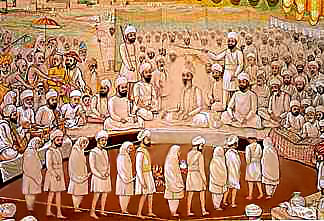 Namdhari Sikhs or the Kuka Sikhs are an unorthodox sect of Sikhism. Namdhari Sikhs accept Jagjit Singh Ji as their living Guru. The Namdhari movement was started by Baba Balak Singh of village Hazro in the North-West Frontier Province. He chose Baba Ram Singh as his disciple and his successor. The Namdharis believe him to be the 12th incarnation of the Sikh gurus as Guru Govind Singh had prophesied. In 1857, Baba Ram Singh formally inaugurated the Namdhari movement with a set of rituals which was modelled after Guru Gobind Singh`s principles of the Khalsa. Namdharis perform the practice of wearing white homespun clothing and by their method of white clothes with a white turban tied horizontally across the forehead. They also wear a white woolen cord (mala), woven as a series of 108 knots and serving as a rosary. These features set them apart from all other groups.
Namdhari Sikhs or the Kuka Sikhs are an unorthodox sect of Sikhism. Namdhari Sikhs accept Jagjit Singh Ji as their living Guru. The Namdhari movement was started by Baba Balak Singh of village Hazro in the North-West Frontier Province. He chose Baba Ram Singh as his disciple and his successor. The Namdharis believe him to be the 12th incarnation of the Sikh gurus as Guru Govind Singh had prophesied. In 1857, Baba Ram Singh formally inaugurated the Namdhari movement with a set of rituals which was modelled after Guru Gobind Singh`s principles of the Khalsa. Namdharis perform the practice of wearing white homespun clothing and by their method of white clothes with a white turban tied horizontally across the forehead. They also wear a white woolen cord (mala), woven as a series of 108 knots and serving as a rosary. These features set them apart from all other groups.
Namdharis abandoned the worship of gods, goddesses, idols, graves, tombs, trees, and snakes. They also did not follow any rituals conducted by Brahman priests and the authority of the hereditary custodians of the Sikh gurdwaras or the Sikh centre of worship. The claims to special status by the Sodhis and Bedis, descendants of the Sikh gurus were condemned by the Namdharis as well. This sect even abstains from drinking, stealing, adultery, falsehood, slandering, back-biting and cheating. Baba Ram Singh introduced changes in the forms of worship, address and in the appearance of his followers to distinguish them from orthodox Sikhs and became an ardent cattle protector.
Similar to the beliefs and moral code of conducts of the Nirankaris, the Namdharis granted women a degree of equality. According to the principles of the Namdharis dowries were rejected, and child marriage forbidden. Eventually, Namdhari worship acquired a new dimension. Sangats were organised in many villages. Each sangat had its own place of worship, a granthi (scripture-reciter) and a free kitchen. The granthi taught Gurmukhi and the Sikh scriptures to both children and adults. Sangats were grouped together and administered by sibds (governors), naib subds (assistant-governors), and jatheddrs (group leaders), whose primary function was to collect funds and remit them to the headquarters at Bhaini.
Namdhari missionaries also started preaching to Sikh troops of the British-Indian army. The period from 1867 to 1870 the Namdharis continued to convert people. In addition to, that the British custom of treating cattle as the source meat was objected by both Hindus and Sikhs. The Namdharis pledged to protect cattle and to end their slaughter. However, many Namdharis were arrested when they tried to end the custom of slaughtering of cattle. A mixed military and police force raided Bhaini and arrested Ram Singh. He was exiled to Burma where he died in 1885. After Ram Singh his younger brother, Baba Budh Singh, became head of the Namdharis. The teachings of Ram Singh and his guru, Balak Singh, promised a return to purified Sikhism of Guru Gobind Singh. Thus, the leadership and membership of the Namdharis existed in the Jat peasant class of Punjab. This segment of society had also supported Guru Gobind Singh and his description of Sikhism. Namdharis had the belief that Sikhism was decadent and degenerate and like the Nirankari they sought to return Sikhism to its past purity. The Namdhari vision of a restructured Sikhism, thus, required a total reshaping of the Sikh community into a militant, religious-political dominion. This reconstruction threatened established religious authority bringing the Namdharis into direct conflict with the British-Indian government. The Namdharis as the transitional movements were concerned with adjusting to the cultural influences of the colonial milieu.
Even today the Namdharis follow the path of Guru Nanak Dev Ji, who laid down the basic principles of Sikh philosophy. They strongly follow the principles of Nam Simran or meditating on God`s name, Kirat Karo or "Earn thy living", Vand Chako "Share thy wealth". In contemporary India, religious places for Namdhari exist in several places.



















